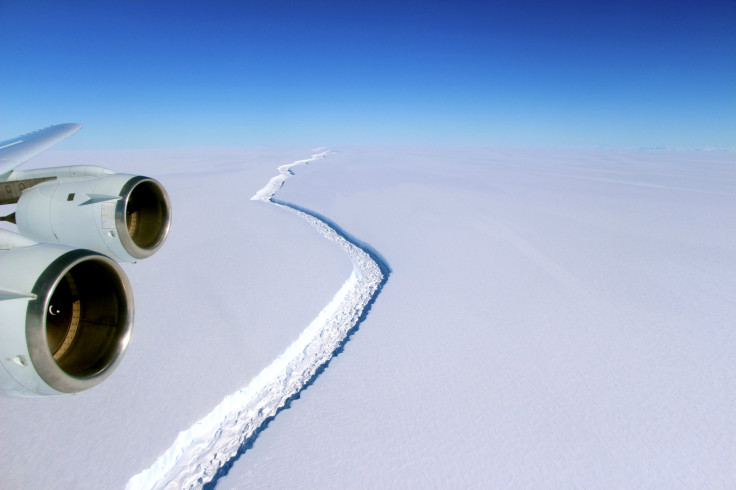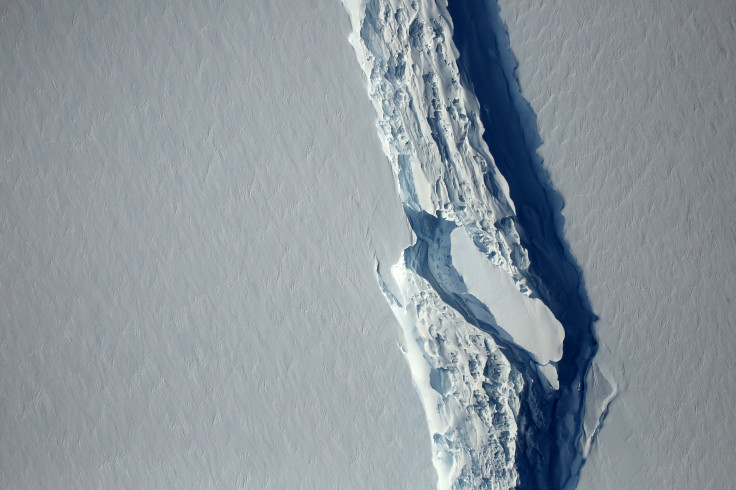Massive Iceberg Breaks Off Antarctica: Delaware-Sized Larsen C Iceberg Breaks Off
An iceberg that has just broken off from Antarctica is so massive that it has been described as being the size of Delaware, or twice the size of the European country Luxembourg.
It snapped off the Larsen C ice shelf in the western part of Antarctica, putting what remains of the ice shelf at a higher risk of collapsing, according to a report from Project MIDAS, a research group based in the United Kingdom that focuses on Larsen C. It happened sometime between Monday and Wednesday and a NASA satellite made the discovery, MIDAS said.
The iceberg is about 2,200 square miles and is 1,100 feet thick, with a volume double the amount of Lake Erie. It weighs more than 1 trillion tons and is one of the largest icebergs ever recorded.
Read: Antarctica Ice Melt Will Help Invasive Species
The breakoff happened after the iceberg kept scientists in suspense for months — they knew the chunk was about to separate via a growing crack in the ice shelf but were unsure of when exactly it would happen.
To give a sense of the true dimensions of the Larsen C iceberg, here's an animation based on real data, with something familiar for scale pic.twitter.com/OdQA07qhBb
Climate change may be one of the first things that comes to mind when considering an enormous iceberg breaking away from Antarctica, but the relationship between the mass and climate change is quite complicated. For starters, although it’s possible for warmer polar temperatures, both in the air above the ice shelf and in the water underneath it, to have sped up the process, icebergs do naturally break off from Antarctica in a process known as calving.
Additionally, even though one element of a changing climate is rising sea levels that are linked to the decrease of polar ice, this iceberg’s escape from Antarctica will not play into that relationship.


“It was already floating before it calved away so has no immediate impact on sea level,” MIDAS said.
One thing it will affect, however, is maps of the continent.
“The calving of this iceberg leaves the Larsen C Ice Shelf reduced in area by more than 12 percent, and the landscape of the Antarctic Peninsula changed forever,” according to the researchers.
And the changes may not stop there. According to MIDAS, a previous ice shelf named Larsen B disintegrated 15 years ago after its own large calving event, and Larsen C may follow suit.
Read: Did Climate Change Force Scientists to Cancel a Climate Change Study?
About the floating behemoth itself — scientists might name the iceberg A68 but it is not official yet — Swansea University’s Adrian Luckman, a lead investigator for MIDAS, said in their report, “It may remain in one piece but is more likely to break into fragments. Some of the ice may remain in the area for decades, while parts of the iceberg may drift north into warmer waters.”
Drifting and breaking into pieces would pose a danger to ships, such as those in the waters surrounding southern South America, according to a report from news service Agence France-Presse. Officials will be keeping a close watch on the iceberg to prevent a dangerous situation.
Breaking news on #LarsenC from @MIDASOnIce! Take a look yourself at the MODIS imagery at https://t.co/vMXIdzdfci pic.twitter.com/CmPkuxBpN6
— Stef Lhermitte (@StefLhermitte) July 12, 2017
© Copyright IBTimes 2024. All rights reserved.











